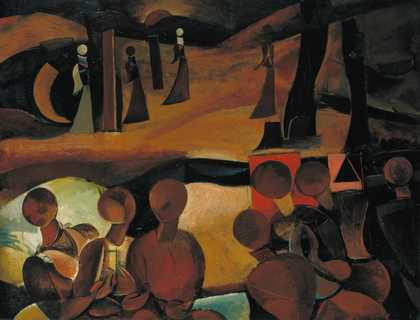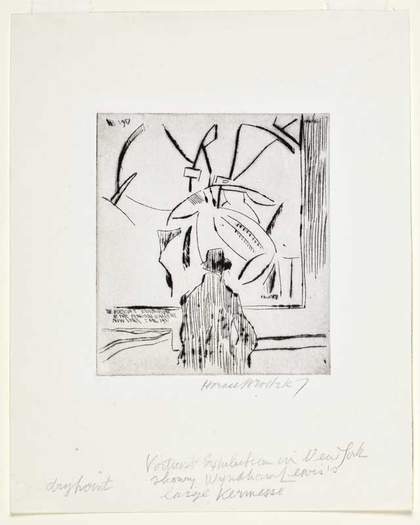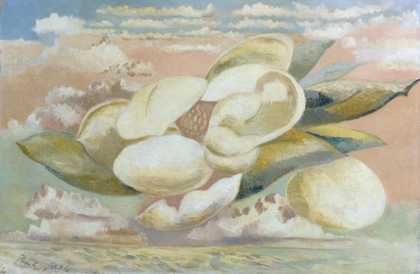History rushes. The crowds in towns,
Cerebral boundaries of nations over mountains,
Actors in flesh and death and material nature,
Dance to a gripless private stammer of shouting
… Thoughts in a dying minister’s brain.1
I begin with this extract from Stephen Spender’s poem (a poem he revised substantially after its first appearance in 1933) because it neatly brings together a number of the things I want to discuss. These include a variety of topics long associated with the sublime, and some specific to the period I have chosen – history, crowds, boundaries, mountains, acting, theatricality, nature and death. The material, in outline at least, will be familiar, and much what I have to say will not be new. But I hope that I shall be able to offer some new explanatory thinking about the imaginative furniture of the period between 1933 and 1939 which may put a fresh gloss on an old story.
Two old stories, in fact, redefining themselves under pressure from communist ideology and versions of psychoanalytic theory. The aesthetic realm during these years, at its political extremes certainly, but by no means exclusively, was probably as un-disinterested, if I can put it like that, as it ever has been. Powerful argument was advanced on both sides of the debate about the autonomy of art, or about the extent to which it might serve a cause and still be valuable, and even the most detached of the serious art of the decade was engaged with the pressures of circumstance and tropes of what one might call the historical sublime. These tropes – frontiers, mountains, futures – and their contexts, and the transformations they underwent and underpinned, animated much of the decade’s cultural production and variously involved heroism, satire, and fear of annihilation.
The ideal of social and political reconstruction (Reconstruction is also the title of a 1933 book of poems by Randall Swingler) first emerged in the literature and art of the late 1920s in response to the interplay of world politics and high modernist aesthetics. Purely in terms of landscapes of the imagination, we can see a shift away from both The Waste Land’s collage landscape of rubbish and abjection (or the use of scraps of newspaper in cubist paintings) and from the atemporal panoramic retrospection of Ezra Pound’s Cantos. The landscape of The Waste Land, which flickers from scene to scene like early cinema, is almost featureless: apart from plains with arid rocks and sand, and London’s bridge, streets, and river, there is only the sea in which Phlebas drowns. The early poems of W.H. Auden, by contrast, are often sharply contoured: many are topographical, ‘the crux, left of the watershed’, ‘Control of the passes was, he saw, the key’. ‘From scars where kestrels hover’.2 Like Cecil Day Lewis and in a different way George Barker, Auden works with the tradition of English landscape poetry, but denaturises it by moving from the south and west of the country to the north, creating an uncanny presentation of nation as home (and also home to civil unease and conflict). As his work progresses, the idea of north itself becomes figurative of an extreme which is both moral and ironically affective, casting its cold light on the politics of Europe. There is also a bare, almost abstract quality to these topographies, so that specificity bleeds into allegory and the physical world shades into something more malleable. In fact, much of Auden’s poetry in the 1930s is shaped by two occluded factors: the first stems from this permeability and can be thought of as an uncertainty about the frontier between dream and documentary; the second, an aporetic contradiction which drives many of his best poems, is the impossibility of desiring a future predicated on his own annihilation. The widespread (if seldom conscious) recognition of these factors is attested by Auden’s popularity during the decade and by the stupefying infectiousness of his cadence, as well as by a growing awareness of what he calls ‘the gathering multitudes outside’, the crowds who, in his poetry, easily transform into flood-water or into the tide of history.
The crowd, another defining concern of modernism, is by this stage subject to a great deal more sociological commentary. In the years just after the First World War, the crowd, in England, was often depicted as epistemologically aimless, or lost in an ‘unreal city’. The crowd that flowed over London Bridge in The Waste Land was a crowd of survivors, scarcely living, undone by war and by death. Later in Eliot’s poem, it is refigured in the menacing ‘hooded hordes swarming /Over endless plains’ in the wake of the Russian Revolution:
What is that sound high in the air
Murmur of maternal lamentation
Who are those hooded hordes swarming
Over endless plains, stumbling in cracked earth
Ringed by the flat horizon only
What is the city over the mountains
Cracks and reforms and bursts in violet air
Falling towers
Jerusalem Athens Alexandria
Vienna London
Unreal
Crowds, where they are not holiday-makers or revellers, tended to be associated with flight, dismay, disorder and demoralisation. The mass of the people was more often seen as liable to fragment and panic than as a constructive force for good, and its primary ideological presence was as the potential for violence and destruction. But by the end of the 1920s, under pressure from the development of mass-media, mass-consumption and mass-production, as well from the political polarisation that followed the Depression, the crowd became a more contested concept, both terrifying and noble. On the one hand, the growing threat of mass-annihilation from the air prompted military, political, and civilian speculation about the breakdown of civilisation, and led authorities considering the likely consequences of an aerial attack to predict desperate crowds, untrammelled by law or convention, rampaging across the ravaged lands, out of control, destructive and terrifying. By contrast, in the new Soviet Union, and in the national parties affiliated to the Communist International, the utopian ideal of the masses evoked the agency of progress and the construction of a new and juster world. The question of the relation between art and the masses created significant and sometimes impossible contradictions for those involved in public or politically-oriented art. For others, like Wyndham Lewis, these difficulties provide material for fiction, satire and comment; but they also offered a way in to thinking about the conceptual limits of the time.
Let me now skip to the other end of the decade, and inject another element into the mix. Towards the end of the decade, in 1937, Lewis signed a contract with the publisher Robert Hale for a novel to be called Men at Bay, which he started writing the following year. It took him three and a half years to complete the novel, eventually called The Vulgar Streak, and both in narration and diegesis it became deeply imbricated with the events in Europe in the year leading up to the outbreak of war. The novel opens in Venice (‘an architectural paradise established on a sewage-farm’, as one character puts it) during the week of the Munich crisis in 1938, and the theatricality, duplicity, counterfeiting, and insubstantiality that surrounds Vincent Penhale, the central character, is interwoven with the political and diplomatic feints and conspiracies emerging from the newspapers and radios. At the outset, the tone is set with a description of a painting by the eighteenth-century painter Francesco Guardi: Penhale and his friend Martin are strolling in the cloisters of St Mark’s Square in Venice, when their attention is caught by a reproduction displayed in a shop window. Lewis writes:
The picture represented a scene in Venice when this extinct show-place – a godsend to Thomas Cook – was alive with passion and intrigue. It revealed what underlay the formal beauty, which today alone remains, like a splendid ball-dress once worn by a mistress of great princes.
A sinisterly darkened lofty apartment, into which a crowd of small masked figures had just poured themselves, gathered in a dark palaver. They had gone aside, into this empty room in some tarnished palace, to set up a dark whisper. Then later, when the maskers had dispersed, probably in a moonlight salizzade or streetlet, a long dagger would flash, a little masked figure would fall, crumpling up like a puppet. Expectant and intent, they crowded their masked faces together.
‘A great swell, G-Guardi!’ stammered Martin dully, his eyes fixed in painful concentration upon the masterpiece.
But his tall friend eyed bleakly the painted scene: the only sensation he was conscious of was fear. He felt personally involved in the plots of these masked and nameless beings of disintegrating pigment, as if they had been plotting against him.3
This unattributed fear of Penhale’s is doubled by the political situation. It is almost immediately after this scene, a page or so later, that we discover the date: it is the last week of September 1938, but Penhale affects not to take the crisis very seriously. ‘All I mean is that we all live under a great shadow today,’ he says to April Mallow. ‘A Last Judgment like sort of a thing. Like a coming eclipse. An unhealthy sort of condition of course. War is only another shadow.’4 The attempt to subsume fear into chiaroscuro is unconvincing, as it is intended to be. In the draft of a letter to H.G. Wells after the book was published, in July 1942, Lewis explained that ‘The time in which we live appears qua period to be a “shocker”. A “thriller” is too mild a word for it. Well, the rather shocking nature of my book was to my mind a faithful interpretation of an epoch where violence is everywhere.’5 Violence, from the most abstract to the most distressingly concrete, was indeed pervasive and ubiquitous in the culture of the 1930s: Lewis’s novel is an attempt to understand the appeal of this violence, and of the role in it of acting, of personal duplicity, and ontological emptiness.
A sense of conspiracy and theatrical disguise is nothing new in Lewis’s work. It can be seen as early as Mrs Duke’s Millions (written about 1909 or 1910) and it is the dominant mode of his engagement with the period. Violence, too, is central to his aesthetic, from the explosive avant-gardism of Blast to the history paintings of the thirties, and to novels like The Revenge for Love (which deals at greater length and more explicitly with these issues). Certain related motifs recur in both his visual and his written work throughout the 1930s (the stage, masks, doubles, birds, especially birds of prey, and so on) and often contribute to an uncanny hallucinatory quality (such as we find in The Vulgar Streak) which is both overdetermined, in the sense that it speaks to more than Lewis knows, and indefinable. What in the novels Lewis works out through character, narrative, symbolism, and authorial comment, takes on a more immediate efficacy in his painting.
I want to take just one image as an example: Red Scene, the first of his paintings to be bought by a public collection, in fact, by the Tate Gallery (fig.1). It takes us back to 1933 again. This is a puzzling picture, as many critics have pointed out. The patch of bright orangey-red, set off by a smaller section of pink, draws the eye continuously back to the permeable border between the two parts of the painting. In the foreground, two groups of figures, mostly women it seems, are engaged in absorbing conversation with their backs to the strange scene taking place behind them; one other figure sits, as if a cinema organ, with her back to the viewer. There seems to be no connection with the stylised landscape behind, with its four winged figures (though the wings look like theatrical paper symbols of wings rather than anything more functional), trees, undulating landscape, and a setting (I think it is setting) sun. And there is also a yellow crescent, like the sheath of a giant scimitar, to the left of the picture. The group in the left foreground radiates a bright luminescence whose range extends as far as the patch of pink, and whose effect is to throw further into obscurity much of the background. In its unreality it recalls the theatre and the cinema, but in the lack of attention paid to the four strange figures it seems more like a dream. It foregrounds a palette focused on red, but refuses a settled perspectival surface. The pictorial plane billows and undulates disturbingly, and different parts of the picture resonate with different horizons of vision, interest and epistemology. Yet the painting as a whole creates a powerful sense of intensity, as if something absent from the painting were nevertheless holding it together like a form of unconscious anticipation or anxiety.
Shorn of the direct allusiveness Lewis can use in the novel, Red Scene stages itself in a play of emptiness and doubling, nonchalance and intensity that takes on something of the landscape atmosphere of allegory, soon to be a more pronounced feature of the decade’s aesthetic. Not the simple allegory of John Bunyan, or even of John Buchan, but a figure that, as the literary theorist Paul de Man puts it, ‘designates primarily a distance in relation to its own origin.’ As pertinent as that abstract distance here is Walter Benjamin’s emphasis on allegory’s kinship with history and ‘the decisive category of time’, to which I shall return later. The best-known example of 1930s allegory is probably Rex Warner’s novel The Wild Goose Chase. Like so much of the more oblique political art of the decade, this novel has its own belatedness. Just as Lewis’s Revenge for Love, a novel about smuggling small arms into Spain, was written in 1934 and 1935 but not published until the Spanish Civil War was an intense reality, in 1937; and as The Vulgar Streak appeared long after the pre-war period it describes, so The Wild Goose Chase dates in part from as early as 1929, and was largely completed by 1933, although it was not published until 1937. I want to draw attention just to a couple of aspects of the novel, beginning with the familiar trope with which it begins, as the brothers set off on their quest: the mountainous ‘moorland road which was to lead them to the frontier miles away, where very few of us had ever been.’
Mountains, in one form or another, are central to the imaginary of the decade, as many critics have pointed out. Not always for their aura of Kantian or Ruskinian sublimity: equally, for their presence as obstacles to be climbed, frontiers to be passed (or possibly not passed, as in Ruthven Todd’s allegorical Over the Mountain of 1939). Mountains are ubiquitous in Auden’s work, as he moves from the passes, uplands and mine-workings of his early poetry – which double as mental and moral topographies to an uncanny unsettling of his readers’ assumptions – to the overt theatrical allegory of The Ascent of F6, and to the deliberately hieratic symbolism of lines like ‘The mountains cannot judge us when we lie’. C. Day Lewis’s poem sequence The Magnetic Mountain, published in 1933, attempts, not always successfully, to naturalise the Stalinist utopia of the newly constructed industrial city of Magnitogorsk in the Soviet Union (the city’s name taken from the eponymous Magnetic Mountain from which the iron ore was mined) while using the trope of magnetism to attract readers to the communist ideal and the sublime of collective purpose.
Follow the kestrel, south or north;
Strict eye, spontaneous wing can tell
A secret. Where he comes to earth
Is the heart’s treasure. Mark it well.Here he hovers. You’re on the scent;
Magnetic mountain is not far,
Across no gulf or continent,
Not where you think but where you are.6
The difficulty of assimilating the sublime constructions of industry to the heroic pastoral frame is evident in this sequence, but the mountain is the central trope in the attempt. Randall Swingler, in a lyric meditation on the political future, explains, ambiguously, that ‘who looks forward, is talking already / behind the mountains of the new message’7 What these repeated tropes have in common is their scale.8 Mountains are all-but-impassible, dangerous, beautiful and protective, a touchstone of sublimity. The austere new views taken from the air by hawk or helmeted airman may add another dimension, even map out a New Country, as does all flight (whether by bird or aeroplane) and its disdain for frontiers. But with the growing popularity of mountaineering and, much more, the commercial development of the aeroplane, they are equally susceptible to tourism and the consequent democratisation of their sublimity. Some sense of forces greater than those at our disposal, either in terms of power, or scale, or mystery, is required for the irrationality of human history to reassert itself into the aesthetic. At the end of The Wild Goose Chase, in an assertion of the power of the incomprehensible to frame and perhaps ironise the triumph of ‘comradeship … profane love … hard work, honesty, the sight of the sun, [and] reverence for those who have helped us’, the aptly named Anserium, a vast structure, is ‘suddenly whirled away, winnowed and dissipated in the upper air like grain or stalks of straw’ and across the sky thus revealed the assembled people see ‘streaming the white shapes of flying birds, a horde, from horizon to horizon’. They are vast, countless, majestic, and silent. ‘And so for mile after mile and for a time that no one could reckon the enormous wild shapes of beauty and strength went over the army.9
Something comparable operates in the 1934 painting by Paul Nash, The Soul Visiting the Mansions of the Dead (British Council).10 Here regular forms derived from sketchy scaffolding, and what look like egg-tray dividers, are counterposed with altogether less defined forms. The conjunction of predictable regularity with the flight of winged souls that look rather like aeroplanes traversing the cloud-flown airy spaciousness of death’s domain succeeds in creating an almost comforting vision of death. What unsettles us is the illusion of infinite distance it creates, the sense of bottomlessness in the blue-purple masses in the lower part of the picture. It is something like this vertiginousness that surfaces from time to time in Warner’s novel, as conventional allegory cannot contain, even in the first part of the decade, the imaginative scope called forth by the intensifying political situation in Europe. Nor, for the most part, can surrealism. Two factors are central here: on the one hand, there is an increasing sense of fear, focused on fear of annihilation, so that a generalised anxiety about violence imbues figures of the sublime with a new potential salience; on the other, there is an increased melodramatisation of the stage of world politics.
Melodrama, because the whole political culture of the inter-war years operates within a melodramatic framework, with a polarisation between good and evil, civilisation and barbarism, Left and Right, and an overwhelming sense of imminent and mortal crisis. In his analysis of melodrama, Peter Brooks has shown how in Balzac’s narratives for instance ‘the center of interest and the scene of the underlying drama reside within what we could call the “moral occult”, the domain of operative spiritual values which is both indicated within and masked behind the surface of reality’.11 Marx’s enthusiasm for Balzac is very much to the point here; his account of human relations as mediated and reified into relations between things, and his account of the occluded operations of class conflict as the motor force of history, operate in a similar manner. In their reduction in the ideological world of the Comintern, these features take on the characteristics of popular melodrama, in which the polarisation of good and evil works towards revealing their presence and operation as real forces in the world. Man is seen to be, and must recognise himself to be, playing in a theatre that is the point of juncture, and of clash, of imperatives beyond himself that are non-mediable and irreducible. This is the essence of the vulgar Marxist view of the world, which renders everything a synecdoche of the global struggle, and gives each believer the power to see beneath the surface of capitalist reality and lay bare the complex mechanism of its true (or objective) constitution. The sense of consciousness itself as something complex, multiple or fragmented, characteristic of modernism, is replaced by one which is singular and self-possessed, the agent of pre-articulated truths. The hyperbolic, theatrical tone of melodrama pervades not only the rhetoric of chiliasm that emanates from the plenums of the Third International from 1929 onwards, but also the hermeneutic stance of the writers who attended to it. In this, it answers to the psychological experience of a problematised subjectivity, and provides an illusory resolution to the contradictions between the terrors emanating from death, barbarism or the necessity for self-annihilation and the heroic future imaged on the other side of the mountain. Even with the protection of technology and a lyrically frail, motorised carapace like this, the individual is menaced by vast forces, by what Karl Radek described as ‘these great facts of reality which threaten to crash down on our heads’.12 People in the 1930s were acutely conscious of the new threat of mass aerial bombardment with high explosive, germ canisters and incendiaries. Even conservative estimates envisaged hundreds of thousands of deaths within days or hours in the event of war; and Baldwin’s dictum that ‘the bomber will always get through’ repeats like a leitmotiv through the period.13 These fears received a new impetus in the latter part of the decade from the Civil War in Spain.
Death from the air became a European reality most starkly in April 1937 with the bombing of Guernica. Images of transformative destruction were widely disseminated through newsreel and newsprint, repeated and multiplied as more towns and cities were subjected to bombing. The most lasting cultural impact came with Picasso’s creation of his vast painting for the Spanish government’s pavilion at the Exposition internationale des arts et techniques de la vie moderne. Here the sheer size and scale of the painting, as well as its monochrome, newsprint-like surface, help to create its impression. The narrative is almost unspeakable, the pain depicted almost unthinkable; it overflows the pictorial space, recomposing gestural fragments of Spanish cultural history to attempt a sublime of historical crisis.
Other images – especially the frequently used image of a child killed by bombs in a Madrid school – speak to a deep ambivalence in the pursuit of shock value, and the thrill of horror, which also fuelled much of the popular fantasy fiction about bombing. A kind of sentimentality is at work here, scaling down the unimaginable, putting it to do more manageable psychic work, turning away from the fear of one’s own death to a refiguring our relation to that of others, as Spender does here:
Beyond the violet violence of the news,
The meaningless photographs of the stricken faces,
The weeping from entrails, the vomiting from eyes,
In all the peninsular places,
My imagination reads
The penny fear that you are dead.Perhaps it is we who are unreal and dead,
We of a world that revolves, dissolves and explodes
While we lay the steadfast corpse under the ground14
Fictions about the collapse of civilisation, about the liberation of the libidinal energy of crowds, work though unconscious narcissistic fantasies of aggression and destruction. These are so bound up with political and subjective anxieties in the years between 1933 and 1939 that they precipitate a fear of death and the void that haunts, and to a large extent constitutes, the sublime in the work of many of the most interesting artists and writers of the period. Unable to represent their own death, or even properly to contemplate their overcoming by the ‘crumpling flood’ of history envisaged by Auden, they transform it into spectacle and themselves into spectators, and therefore survivors. The unspeakable and the unimaginable are summoned up in figures of infinity: in crowds, in mountains, in endless perspectives, fathomless depths, unscaleable peaks, and other dreamlike elements in painting and writing.
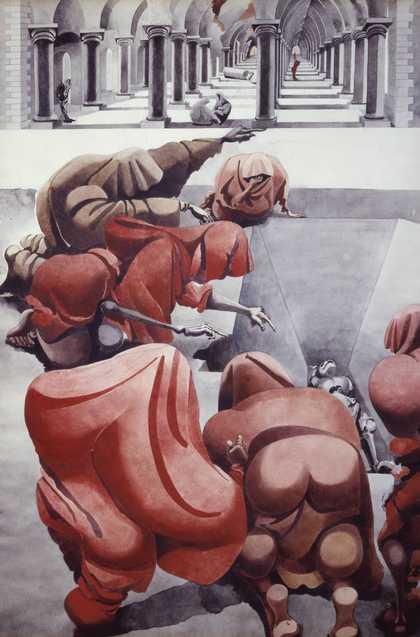
Edward Burra
[title not known] (1940)
Tate
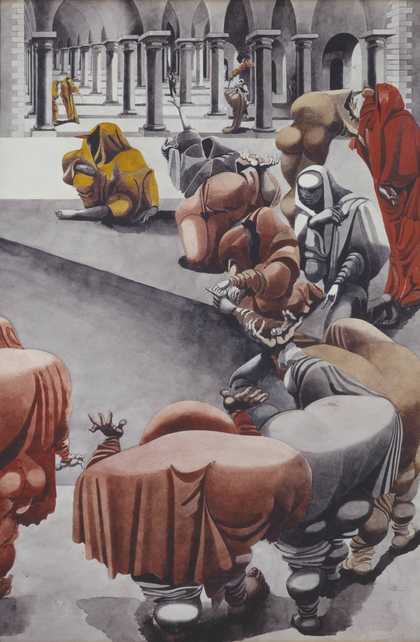
Edward Burra
[title not known] (1940)
Tate
The stylised attitudes of the hooded figures contemplating stark, skeletal death in the disturbing diptych by Edward Burra, Wake 1940 (fig.2) , are echoed in the long and desolate rows of columned space. To the extent that they are almost entirely faceless, they reinforce the sense of anonymity and spectatorship. Allegory and irony may try to create perspectives in which these crucial and impossible facts or intimations can be captured; and theatricality, sentimentality and satire may try to cut them down to a manageable size; but, ultimately, the sublime remains an uncanny and ungraspable presence. It retains its salience and its invisibility because it has itself become a sublimation: the sublimation of a historical moment, even of time itself. Time in art of the 1930s is so often allegorised as History, and History as a stage waiting for the denouement of a political melodrama, that it develops a patina of controllability. The rapidly sclerotising dogmas of Soviet communism promise a rational science of history, and a template for Progress. But the truth is that there was no script waiting to be enacted, no great conspiracy waiting to be unmasked, no singular or even binary future. Time, however hypostatised, is always the frontier of the unknown. Sublimated, as in Paul Nash’s painting Landscape from a Dream 1936–8 (fig.3) it becomes mountains, cliffs of fall, crowds, mirrors, frames, hawks, clouds, sea, history, death and material nature, and animates all the uncanny presences that haunt the rational anti-sublime of a melodramatic decade.
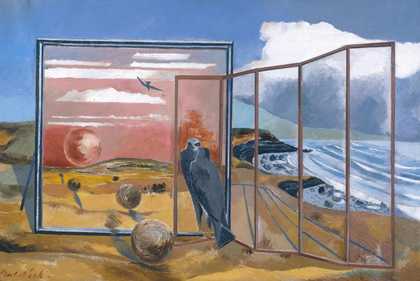
Paul Nash
Landscape from a Dream (1936–8)
Tate

